I’m coming to the conclusion that most people, maybe even most Ferndale City Council members, don’t really know the full extent of our water issues. And to be blunt, in my view this is because this City administration is fairly opaque rather than transparent as they so often claim about themselves.
Here’s the kind of things I read:
4-4-2017 – According to Public Works Director Kevin Renz, the goals for digging the third well into an aquifer beneath the city are to provide redundancy in the event another well should fail, increasing the City’s available water supply and exploring the depth of the aquifer up to 1000′. My Ferndale News
5-7-2018 – According to Public Works Director Kevin Renz, the goals for drilling the well included providing redundancy in the event either or both of the other two wells should fail, My Ferndale News
7/30/2018 – Last year, the city reported seeing reservoir levels drop significantly during the last week of July and into first few days of August which resulted in an emergency city council meetingand ultimately the implementation of mandatory watering restrictions – My Ferndale News
7/31/2018 – Ferndale used to draw its water from the Nooksack River but in 2011 began drawing from wells, Sweeney said.
A limited amount of water can be pumped daily, and Sweeney said the city’s water use is so high that officials fear that a large fire would deplete the water on hand temporarily, he said. Bellingham Herald
3-26-2019 – Seeking to be proactive about protecting the city water supply after seeing reservoir levels take an unprecedented and sudden dip over several days last summer, city staff will be… My Ferndale News
5/29/2019 – All reports point towards it being a scorching hot summer this year which can have a drastic impact on the local water supply. To help ensure that everyone has the water they need throughout the dry season, the City is implementing a mandatory water conservation schedule City of Ferndale
Most people that I talk to follow some sort of local news or social media and for the most part seem to believe that we have a seasonal water problem where we just use a bit too much water in the summer. And then they cite the obvious, that this is a mild thing because the river is still flowing, new housing keeps being built, and the mandatory odd/even day restrictions are merely annoying rather than a big deal. On the other hand, I think our water problems are in fact a big deal.
So here’s a bit of a list of things that I now know, that maybe you don’t, that make our water issues a big deal. This could also be known as a list of things that maybe the City is not really being so transparent about:
- As the transition from river to well water was happening, the City was warned by their consultants, RH2, that salt water intrusion/brackish water would be an indicator that we are over pumping the wells and that output would need to be reduced to maintain supply. Even at the time of moving to the well system, the capacity of the wells were in question.

- So you’d think that given this warning, the City would be closely monitoring the situation and maybe that is the reason that they are mildly restricting use. That’s actually what I thought until I did a records request and had a phone conversation with the Chief Plant Operator at the City’s water treatment plant. What I found though is that the City has not been testing the raw (as pumped) water for indications that salt water intrusion, in fact they hadn’t tested the raw water since they began using wells. They do test the water they produce which ensures we get legal water, but without testing the raw water they have no way of determining the health of the aquifer, they only know if they can pump water out of the hole or not. BTW, the City uses reverse osmosis(RO) filters so they can process salty water, the average farmer who draws from the same aquifer as the City will also be drawing salty water created by the City’s over use, but they probably won’t be able to afford to have RO filters.
- A broader perspective on seawater/saltwater intrusion can be found in this document – Seawater Intrusion in Washington: What does it mean to us?. I”ll give you a clue, the broader perspective is bad for more than just your begonias.
Some coastal wells in Washington are now unusable because of seawater intrusion. This is particularly true in coastal areas where high population growth has placed increased demands on groundwater supplies. Seawater intrusion can potentially render large portions of Washington’s coastal aquifers unusable through degradation of water quality. Washington State Department of Ecology
-

Line charts make it so easy to spot problems. Shop Well use began rapid drop in 2013 at the same time that Douglas Well use dramatically increased Then there is this, check out this chart based on data that I’ve gotten from the City, again through records request. The City has relied on two wells drawing from the same regional aquifer to supply us water since the switch from the river. However the Shop Well began ailing in 2013, and then essentially died in 2015 as a result of the lowered water table. How many people know this?
- And also on the failed well subject, check the first two quotes above again. In 2017, the recently hired public works director used the words, “…in the event another well should fail…”, so the city recognized the problem then. But a year later the words were “…in the event either or both of the other two wells should fail…”. Huh? Had one of the wells miraculously “unfailed” or did the City modify their “message” to the public.
- To compensate for the failing Shop Well, we’ve been pumping almost exclusively from the Douglas Well, with many months having the Douglas Well supplying 3-5 times the amount of water than it did in 2012, back when both wells shared the load more equally. The Douglas Well draws from a different location, but still in the same regional aquifer and the water table for that location is also being lowered as well, meaning that the Douglas Well is likely on the same path to failure as the Shop Well.
- From the data, the Shop Well declined rapidly and if that is an indication of what could happen with the Douglas Well we could be in big trouble. I couldn’t locate any arrangements that the City has in place to supply us water on anything other than an emergency basis. The City administration looks like it is banking our future water needs on a “new” deep well that even if approved, won’t likely be online until ????? and only after an expensive new treatment facility because it is already brackish(saltwater) from the get go. Check the trend in water table decline on the image and see that we could be flirting with another dry well in just a year or two.

Stair steps show systematic year to year decline without year to year recovery. This is the only well currently supplying water to City of Ferndale. -

NOAA page, Even above normal rainfall can’t combat over pumping ground water. A lowered water table contributes to drought like surface conditions even when rainfall is above normal. How many people realize that we’ve actually had above normal rainfall in this area for 9 out of the last 10 years? That’s not what you hear from the City when they talk about water conservation, is it? NOAA Climate at a Glance for Whatcom County
- The City of Ferndale is a major user, but not the only user, of the regional aquifer. I wonder what their rational is for abusing this shared resource? It must be a legal thing, because it hardly seems ethical.
Suffice to say that the City paints quite a different picture of our water issues than the picture painted by factual data. I also won’t say that the City has done anything that is technically illegal, however I will say that if our growth plan is based on the output of both the Shop Well and the Douglas Well, then this City administration has been negligent by not updating our growth plan to suit our current situation as well as negligent by not informing us of our actual situation. Like so many things, the first step to finding a solution is admitting to the public that we have a problem. Then we can have an open honest dialog and build livable and sustainable solutions. I am sure it is doable.
Read this quote the City of Ferndale’s Public works director describing the need for the 3rd well.
5-7-2018 – According to Public Works Director Kevin Renz, the goals for drilling the well included providing redundancy in the event either or both of the other two wells should fail, My Ferndale News
“…in the event either or both of the other two wells should fail” said a couple of years after one of the wells had essentially failed and the other was on a clear course to failure. As I mentioned, I think that water issues, like so many other issues in Ferndale, can be solved, but only through open and honest dialog. I think the current administration in Ferndale comes up short on open and honest dialog.
We can’t keep pumping water out of the ground faster than it can be recharged and not expect consequences.
My takeaways:
- Our regional aquifer has and still is being overused by the City of Ferndale to supply its customers water.
The aquifer’s water table has been lowering season to season without recovery since the City began using them 5-6 years ago. - One of the two wells essentially failed in 2015, the other is still on a fast track to failure.
- Systematic over pumping wells in this manner can permanently damage aquifers so that they may never recover even after overuse is curtailed. Damage can come from both reduced capacity as well as salt water infiltration.
- The City has known of this whole situation all along the way, it is not new information, yet the particulars of our situation were not shared with us by the City. Rather, the City has and still is sharing this situation as a seasonal annoyance rather than an ongoing and rapidly worsening situation while failing to properly address the problem.
- We currently don’t have capacity, nor redundancy, to add more customers, yet this City administration is adding customers. Also, to be fair to all aquifer users, especially farmers, we should be on year round mandatory water restrictions until the water table recovers and we have a new source such as a 3rd deep well.
- Even if a 3rd deep well is added(there are issues), this and the previous City Administration’s mishandling of our current wells over the last 5-6 years, gives me little confidence that they will not continue to damage our regional aquifer and also do the same to yet another aquifer. We need to have a firm policy in place to prevent them from doing further damage.
Most of this information came from Google searches as well as a couple of record requests, and nosing around the City of Ferndale site as best I could. I will add a few links here when I find the time, or the City of Ferndale could just make them public and easily accessible. 😉
7/4/19 Update: The City responded to my original post, above the line^, through Facebook and an article on My Ferndale News
I have two, maybe three, thoughts about the City’s responses to my Ferndale Water Issues post. First, Riley is good at his job. Second, the City really likes putting out propaganda and misinformation. Third, I’m annoyed that I feel obligated to make a response to support my original post, that I’m feeling is already fairly accurate. So, if you find a half written sentence or the likes, it is because I have spent as little time as possible on this response.
So here are a few of clarifications regarding My Ferndale News: City Responds to Claim of a “dying well”.
“he asserts a decrease in production from 1 of the 2 city wells is an indication that it is a dying well, likely the result of salt water contamination.
Sure ok, partially true, I might have said “dying” somewhere in my post. My research based gut feeling is that there could be more salt water intrusion going on in one or both of the wells than there was when they were tested back in 2007, but the lack of water available to pump and the year to year reduction in their local water table, not the salt, is why I even brought the word “dying” into the discussion. Reading the charts, I can see that the wells do a partial seasonal recharge each year, not significant and never to the levels of the previous year.
City’s response: “This article raises concerns about sea water infiltrating our wells. Short answer, the City has followed the recommendations of the consultants in the report and all the health department monitoring requirements and it is not a concern at this time.”
Editor’s note: It can be seen in the annual water quality reports produced by the city that there has been ongoing testing of raw water.
This is one of the misdirection/misinformation responses I’ve come to expect from the current City administration. I didn’t and I do not argue that all of the legal monitoring and the consultants recommendations weren’t followed, however the “canned” annual reports do not show testing for saltwater intrusion, just Total Organic Carbon(TOC), and my records request, as well as a phone call with the City, both tell me that no testing was done by the City on raw water since 2007(see gallery below) I also included a cautionary note that was in the consultants report saying that the Department of Health will likely require frequent monitoring for chlorides(salts) that indicate saltwater/seawater intrusion. So, both the City’s response and the Editor’s note are true, but so apparently is the fact that the raw water has not been monitored frequently for chlorides that might indicate saltwater intrusion. Legal does not always mean right.
Wallace: “… the Shop Well began ailing in 2013, and then essentially died in 2015 as a result of the lowered water table.”
City’s response: “Before we installed the RO [reverse osmosis] units, we were able to utilize the softer water from the shop well, once RO units were online, we flip flopped, pumping more out of the Douglas well, because it is more reliable (since it is deeper).”
I will stick with essentially died, because (referring to the data) the Shop Well doesn’t look like it has been able to produce any sustained high volume pumping without it’s water table dropping below it’s intake (straw at the bottom of a milkshake) And knowing that the intake is positioned at the bottom of the aquifer… yeah I’ll again stick with essentially died. And more reliable since it is deeper? (headshake). We just haven’t gotten to the bottom of the milkshake yet.
It’s at this point, that I will point out that when you pump water out of an aquifer there becomes space for more water in the aquifer. The space in the aquifer will fill with whatever water is available: fresh water seeping down, fresh water flowing under ground, or sea water. Another possibility is that the empty space is filled with dirt from above, as in the ground sinking, it’s called subsidence. There are always consequences to manage or mismanage.
Editor’s note: The city activated the reverse osmosis water softening system in late 2014. During a Public Works and Utilities Committee meeting on August 15, 2018, Public Works Director Kevin Renz discussed how the 2 wells were being utilized. He explained the Shop Well was being utilized only during the summer months and turned off during the winter months. It was being maintained as a “very precious resource during the times we need it.”
I totally agree, water in the Shop Well is a very precious resource, and from the looks of the charts, the Shop well is only used during the summer because that’s when they can’t pump what they need from the Douglas Well, but after pumping from the Shop Well, it now takes the rest of the year to get even the smallest amount of recharge.
Wallace also provided a graph of data detailing daily minimum and maximum water levels at the Douglas Road well over time. The graph shows both levels on a consistent decline. The city’s response on Friday to this information was, “All the aquifers in Whatcom County are showing reduced levels as the climate continues to warm – adding a third well will help address that downward trend as well as add some much needed redundancy.”
Yes, and everyone is getting tattoos, or if you are a Lemming, then everyone is jumping off cliffs. Saying that everyone else’s aquifers are “showing reduced levels” doesn’t change the fact that ours is showing reduced levels and has been in decline, it only strengthens the position that we should have been made fully aware of the problems sooner, so that we could be helping, and maybe slowing growth, rather than arguing about whether we need to be watering our lawns on odd or even days. Also if the wells aren’t in a consistent decline, why would the City say, “adding a third well will help address that downward trend…” Isn’t them saying a “downward trend” the same as me saying “consistent decline”?
And the third well will certainly help when and if it goes online. But also, as I said, it costs more to pump from the deep well than the existing shallow Shop & Douglas wells and given its known salinity, it will also cost more to treat. Couple the higher cost with the fact that not only don’t we have a guarantee from the City that they won’t keep taking every last bit of water out of current wells, they said they still expect to pump 2/3 of our needs from existing wells and 1/3 from deep well. The City feels that moving 1/3 of their needs to the deep well would conceivably allow the shallow wells to recover. Will pumping at 2/3 the rate of today’s needs actually allow them to recover? What about at future needs? How about quit pumping from the shallow wells as soon as the deep well is up to help other well users, farms, stream flow, and general health of the land in our community?
Source: City of Ferndale – August 2018
At the August 2018 Public Works and Utilities Committee meeting, Renz presented the same graph and explained the aquifer had declined about 50-feet and that the rate of decline was slowing. Renz said he expected to reach a point of equilibrium at some time in the future when the decline would end. The decline was consistent between both wells, Renz said.
When is “sometime in the future”? Has the rate of decline really slowed? Eyeballing the chart I’d say okay maybe it has slowed slightly on the Douglas Well and certainly slowed on the Shop Well…because we reached the bottom of the aquifer. I may do a will have to pick a date, like jan 1 and compare min/max water levels from year to year and chart it out. Might need to look at total decline also as aquifers are connected. It is also possible that when the upper part of the aquifer is too low then water quits recharging the lower aquifer portions??
Bringing a 3rd well online continues to be a work-in-progress according to city staff. While the well, referred to as Shop Well #2, was drilled in 2017 and reached a seemingly untapped aquifer at a depth of about 1000-feet, there are health, water rights and construction processes to go through before it can be brought online as another source for the city water supply. The latest estimate is for the well to be brought online some time next year.
And the elephant is still in the room. Will the recharge occur with salt water, fresh water, or a mix. I hope more fresh than salt, hough I read somewhere that aquifers closer to the ocean more likely turn salty even if rain/snow is filling aquifers because the coastal shallow aquifers are last to see water from the mountains especially is all aquifers are getting depleted.
Another thing that I haven’t had time to research, and likely won’t, it the amount of water that is currently being pumped from the existing Douglas Well after the City combined water rights for the Shop & Douglas Wells. Again, not saying anything legally done wrong, but a lot of language in the documents that I’ve come across warned about the effect of increased use of the Douglas Well or adding more wells to the south of the Douglas Well, would have on wells in the Imhoff area as well as inviting seawater intrusion into the regional aquifer. Maybe someone else wants to do the researching on this?
7-11-19 another quick add on to this post. Ferndale’s current mayor, in a campaign clip, again espouses the City’s positions that we have plenty of water, saying it’s not the problem, and that we practice sound and careful conservation during the summer months to make sure our reservoir tanks are “recharged” or fill back up for safety reasons (ability to fight large scale fire). I still find this to be a bunch of misdirection/misinformation since it doesn’t address the year to year falling water table, but does state the legally imposed minimum water levels for fire emergencies as if it were some magnanimous gesture on the City’s part. I won’t link to the clip because I just don’t want to traffic disinformation campaigns by the City/incumbent mayor, it’s not hard to find though.






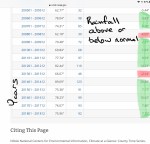


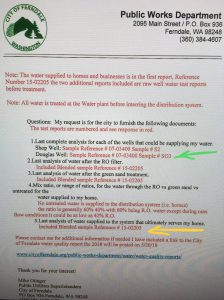

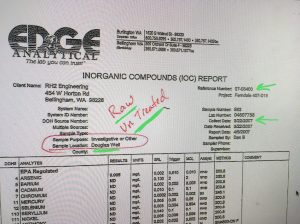
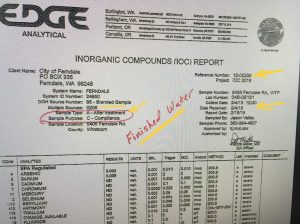
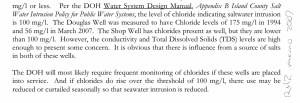
Leave a comment